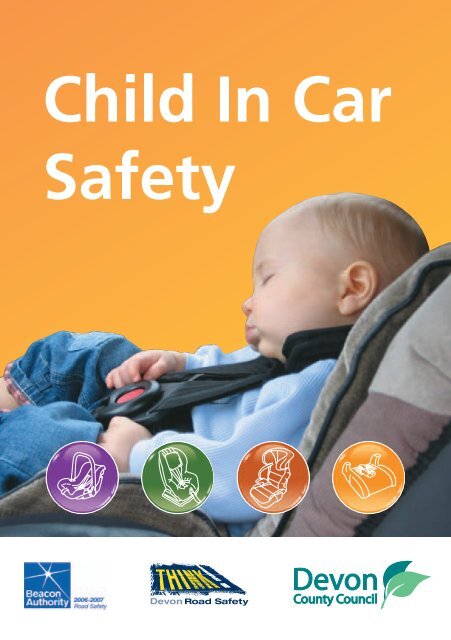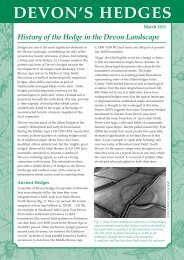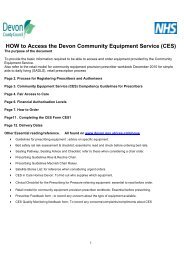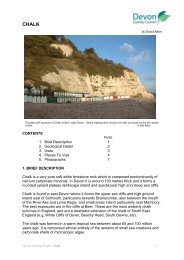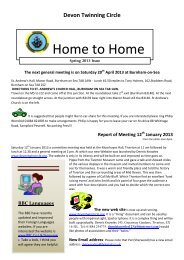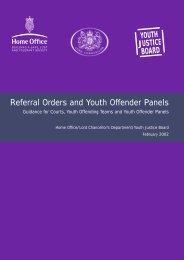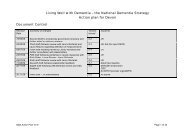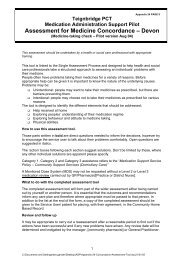119877 Child in Car Safety Leaflet
119877 Child in Car Safety Leaflet
119877 Child in Car Safety Leaflet
Create successful ePaper yourself
Turn your PDF publications into a flip-book with our unique Google optimized e-Paper software.
<strong>Child</strong> In <strong>Car</strong><br />
<strong>Safety</strong>
<strong>Child</strong> In <strong>Car</strong> <strong>Safety</strong><br />
Purchas<strong>in</strong>g and fitt<strong>in</strong>g appropriate child car<br />
restra<strong>in</strong>ts is vital but complicated<br />
Follow<strong>in</strong>g the advice <strong>in</strong> this leaflet will help you to protect the<br />
children travell<strong>in</strong>g <strong>in</strong> your vehicle<br />
Every year children are killed or seriously <strong>in</strong>jured <strong>in</strong> collisions<br />
on British roads where they are passengers <strong>in</strong> vehicles.<br />
In many of these crashes children will have been placed<br />
<strong>in</strong> <strong>in</strong>correctly fitted child restra<strong>in</strong>ts. No matter how well<br />
designed restra<strong>in</strong>ts are, if they are not fitted correctly<br />
they can be useless <strong>in</strong> a crash.<br />
We know you will want to make every effort to<br />
protect the children <strong>in</strong> your vehicle. However, we<br />
also know that the fitt<strong>in</strong>g and adjust<strong>in</strong>g of child<br />
restra<strong>in</strong>ts can be very daunt<strong>in</strong>g for many people.<br />
We hope that this leaflet, together with the<br />
help l<strong>in</strong>es offered by most lead<strong>in</strong>g<br />
manufacturers, will help you to make the best<br />
use of your restra<strong>in</strong>ts.<br />
The law requires you to use a child car<br />
restra<strong>in</strong>t and when well fitted and <strong>in</strong> good<br />
condition, they can be very effective <strong>in</strong><br />
prevent<strong>in</strong>g <strong>in</strong>juries to children.
The Law - a useful guide to responsibility<br />
<strong>Child</strong> car seat regulations<br />
The regulations govern<strong>in</strong>g the use of child car seats came <strong>in</strong>to force on 18<br />
September 2006. There is a standard fixed penalty for not us<strong>in</strong>g a child restra<strong>in</strong>t<br />
and if the case goes to court the f<strong>in</strong>e can be much greater.<br />
Front seat Rear seat Who is<br />
responsible?<br />
Driver Seat belt MUST be<br />
worn if available.<br />
Driver<br />
<strong>Child</strong> up to 3 years* Correct child Correct child restra<strong>in</strong>t Driver<br />
restra<strong>in</strong>t MUST be MUST be used*. If one is<br />
used*. not available <strong>in</strong> a taxi,<br />
may travel unrestra<strong>in</strong>ed.<br />
<strong>Child</strong> from 3rd Correct child Correct child restra<strong>in</strong>t Driver<br />
birthday up to restra<strong>in</strong>t MUST be MUST be used where seat<br />
135cms <strong>in</strong> height used***. belts fitted.<br />
(approx 4’5”) or 12th MUST use adult belt if the<br />
birthday whichever correct child restra<strong>in</strong>t is<br />
they reach first** not available:<br />
<strong>in</strong> a licensed taxi/private<br />
hire vehicle;<br />
for a short distance for<br />
reason of unexpected<br />
necessity;<br />
two occupied child<br />
restra<strong>in</strong>ts prevent fitment<br />
of a third.<br />
A child 3 and over may<br />
travel unrestra<strong>in</strong>ed <strong>in</strong> the<br />
rear seat of a vehicle if<br />
seat belts are not<br />
available.<br />
<strong>Child</strong> over 135cms Seat belt MUST be Seat belt MUST be worn Driver<br />
(approx 4ft 5<strong>in</strong>s) <strong>in</strong><br />
height or 12 or 13<br />
years<br />
worn if available. if available.<br />
Adult passengers Seat belt MUST be Seat belt MUST be worn Passenger<br />
(ie 14 years and over) worn if available. if available.<br />
cont<strong>in</strong>ued overleaf
In addition, the revised regulations also say that rear-fac<strong>in</strong>g baby seats MUST NOT<br />
be used <strong>in</strong> a seat protected by a frontal air-bag unless the air-bag has been<br />
deactivated manually or automatically.<br />
* <strong>Child</strong>ren under 3 years MUST use the child restra<strong>in</strong>t appropriate for their<br />
weight <strong>in</strong> all cars, vans and other goods vehicles, with the s<strong>in</strong>gle exception for<br />
the rear of taxis. They cannot travel otherwise. This means for example that<br />
they may not travel <strong>in</strong> cars, vans or goods vehicles which do not have seat<br />
belts <strong>in</strong>stalled.<br />
** Examples. A 7 year old who is 140 cms tall is over the height for a child<br />
restra<strong>in</strong>t and may use an adult seat belt. A 12 year old who is 130 cms tall is<br />
over the age threshold and therefore may use an adult belt.<br />
*** If no seat belts are fitted <strong>in</strong> the front, then children under 135 cms <strong>in</strong> height<br />
(who are also under 12 years of age) cannot travel <strong>in</strong> the front.<br />
Advice - buy<strong>in</strong>g the right seat<br />
• Remember that vehicle <strong>in</strong>teriors can vary considerably, so ensure that you get<br />
the best fit of child seat for your model.<br />
• Don’t expect your child seat to fit several different vehicles – always try before<br />
you buy.<br />
• Always follow the manufacturer’s <strong>in</strong>structions.<br />
• Don’t assume a seat is safe because of a media safety rat<strong>in</strong>g – it may not have<br />
been tried <strong>in</strong> your type of vehicle.<br />
• Be careful when mak<strong>in</strong>g purchases from <strong>in</strong>ternet sites, standards may vary from<br />
country to country and you can’t necessarily check the suitability for your<br />
vehicle.<br />
To make it easier for you to choose your child car seat, you will f<strong>in</strong>d they are<br />
divided <strong>in</strong>to several groups or categories. The weight range generally determ<strong>in</strong>es<br />
each category.<br />
Group 0 Up to 10kg (22lbs) 0 to 9 months approx.<br />
Rearward-fac<strong>in</strong>g baby seat.<br />
Group 0+ Up to 13kg (29lbs) 0 to 9 – 12 months approx.<br />
Rearward-fac<strong>in</strong>g baby seat.<br />
Group 1 9 to 18kg (20 – 40lbs) 9 months to 4 years approx.<br />
Forward-fac<strong>in</strong>g child seat with <strong>in</strong>tegral harness. Often have adjustable seat<strong>in</strong>g<br />
positions.<br />
Group 2 15 to 25kg (33 – 55lbs) 4 to 6 years approx.<br />
Forward-fac<strong>in</strong>g child seat or booster seat which uses a seat belt. The booster seat<br />
lifts the child and positions the adult lap and diagonal seat belt correctly.<br />
Group 3 22 to 36kg (48 – 79lbs) 6 to 12 years approx.<br />
Booster cushion. They do not offer as much protection as a booster seat with back.
WARNING! YOU ARE STRONGLY ADVISED NOT TO BUY OR USE<br />
A SECOND HAND CAR SEAT<br />
• Many seats sold through private adverts and car boot sales have been found to<br />
be defective and thus dangerous.<br />
• You can never be certa<strong>in</strong> how it has been used or whether it has been <strong>in</strong>volved<br />
<strong>in</strong> a crash.<br />
• They may be worn or <strong>in</strong>complete and often have no fitt<strong>in</strong>g <strong>in</strong>structions.<br />
• You are unlikely to get a seat made to the latest safety standards.<br />
Fitt<strong>in</strong>g<br />
A child’s weight is the pr<strong>in</strong>cipal determ<strong>in</strong><strong>in</strong>g factor <strong>in</strong> select<strong>in</strong>g<br />
the right seat.<br />
It’s easy to make a mistake fitt<strong>in</strong>g a child restra<strong>in</strong>t but the advice below will help<br />
you ensure it is fitted as safely as possible. Not all seats fit all vehicles.<br />
A wobbly seat, a loose seat belt or slack harness, a seat belt go<strong>in</strong>g the wrong way<br />
or a small defect <strong>in</strong> the seat are all common faults which might put a child at risk.<br />
• Opt for the middle of the back seat (if the child seat is suitable) as this is the<br />
safest position, followed by either side of the back seat and lastly the front<br />
passenger seat. The front passenger seat should never be used if an airbag is<br />
fitted.<br />
• Always follow the manufacturer’s <strong>in</strong>structions carefully and keep them safe for<br />
future reference. These <strong>in</strong>structions show the way the seat was designed to<br />
work <strong>in</strong> safety.<br />
• Ensure the seat belt buckle is properly latched <strong>in</strong> place and the red button is<br />
accessible.<br />
• Ensure that the seat belt is not twisted.<br />
• Use only the vehicle seat belts or a purpose built<br />
fix<strong>in</strong>g kit to secure the child seat. Us<strong>in</strong>g belts<br />
or ropes, for example, can leave the child<br />
seat not properly secured and unsafe.<br />
• Never modify the child seat <strong>in</strong> any way.<br />
• Check that the child seat is secure<br />
before each journey you make.<br />
• <strong>Child</strong> car restra<strong>in</strong>ts should never be<br />
fitted on a sideways or rear-fac<strong>in</strong>g<br />
seats.
Rearward-Fac<strong>in</strong>g Seats<br />
• Rearward-fac<strong>in</strong>g is the safest way to travel.<br />
A child should rema<strong>in</strong> rearward-fac<strong>in</strong>g until either they have<br />
outgrown the weight limit on the seat or their head is level<br />
with the top of the seat. It is recommended that a child should<br />
not be put forward-fac<strong>in</strong>g until they weigh a m<strong>in</strong>imum of 9kg<br />
(20lbs) and can sit up unaided.<br />
• On a rear-fac<strong>in</strong>g child seat make sure that the harness’ shoulder straps are level<br />
with or slightly below the child’s shoulders.<br />
• Allow only two f<strong>in</strong>gers’ thickness between the harness and the child’s chest.<br />
Remember that slack <strong>in</strong> the harness drastically reduces the protection offered.<br />
• Ensure the handle is <strong>in</strong> the correct position when be<strong>in</strong>g used <strong>in</strong> a vehicle.<br />
• It is recommended that a baby should not stay <strong>in</strong> an <strong>in</strong>fant carrier for periods<br />
exceed<strong>in</strong>g 2 hours at a time.<br />
Forward-Fac<strong>in</strong>g Seats<br />
• When mov<strong>in</strong>g a child onto this stage we recommend a seat<br />
with a full harness. A recl<strong>in</strong>e function offers greater comfort<br />
for your child on long journeys.<br />
• To make sure a seat is tightly <strong>in</strong>stalled take hold of the seat<br />
harness and pull it. There should be only very slight movement<br />
from side to side and no forward movement. If there is a lot of<br />
play, put your weight on the child restra<strong>in</strong>t to press it firmly<br />
<strong>in</strong>to the car seat. Then tighten the seat belt fully.<br />
• The seat belt buckle should rema<strong>in</strong> straight when tensioned.<br />
If the buckle is stressed aga<strong>in</strong>st the child seat frame the<br />
buckle could snap open <strong>in</strong> a collision. This is known as buckle<br />
crunch.<br />
• The harness pads are worn aga<strong>in</strong>st the chest, not the shoulders.<br />
They cushion the child’s chest prevent<strong>in</strong>g the harness cutt<strong>in</strong>g <strong>in</strong> when the seat is<br />
thrown forward <strong>in</strong> a crash.<br />
• Allow only two f<strong>in</strong>gers’ thickness between the harness and the child’s chest.<br />
Remember that slack <strong>in</strong> the harness drastically reduces the protection offered.<br />
• On a front-fac<strong>in</strong>g child seat make sure that the harness’ shoulder straps are level<br />
with or slightly above the child’s shoulders.<br />
• A child has outgrown a forward-fac<strong>in</strong>g seat when the child’s eye l<strong>in</strong>e is above<br />
the top of the seat or they have outgrown its weight limit.
Booster Seats and Cushions<br />
• We recommend that older children use a booster seat with<br />
backrest, as this gives the child greater protection.<br />
• Booster seats and cushions cannot be used with a lap belt.<br />
• When us<strong>in</strong>g a booster cushion, the seat belt must be positioned<br />
with the lap section across the thighs, not the stomach, and the<br />
diagonal section rest<strong>in</strong>g on the shoulder.<br />
• Us<strong>in</strong>g a booster cushion could elevate a child’s head above the top of the car<br />
seat. If no head restra<strong>in</strong>t is present a child is at risk of susta<strong>in</strong><strong>in</strong>g whiplash<br />
<strong>in</strong>juries.<br />
• Do not use an ord<strong>in</strong>ary cushion <strong>in</strong>stead of a booster cushion, as it does not<br />
provide sufficient protection for a child and is not an approved safety device.<br />
Seat belts<br />
Before the start of each journey check that the car seat is fitted<br />
correctly.<br />
• Seat belt webb<strong>in</strong>g should be checked for signs of<br />
wear, for example cuts, holes, fray<strong>in</strong>g and mildew.<br />
Also look for <strong>in</strong>complete, <strong>in</strong>secure or repaired<br />
stitch<strong>in</strong>g.<br />
• Make sure buckles are not weak or broken.<br />
• A seat belt, which has been <strong>in</strong>volved <strong>in</strong> a collision<br />
becomes permanently elongated, loses its shock<br />
absorb<strong>in</strong>g properties and must be replaced.<br />
• Make sure your seat belt buckle is <strong>in</strong>tact<br />
and <strong>in</strong> good work<strong>in</strong>g condition.<br />
If unsure seek advice from an MOT<br />
registered garage or vehicle<br />
dealer.<br />
• We do not recommend the use<br />
of a lap only belt for children as<br />
they do not offer adequate<br />
protection and could result <strong>in</strong><br />
abdom<strong>in</strong>al, sp<strong>in</strong>al, head and limb<br />
<strong>in</strong>juries.
Airbags<br />
• Never use a child seat on a front passenger seat fitted with an airbag. In a crash<br />
the airbag will <strong>in</strong>flate and cause <strong>in</strong>jury to the child.<br />
• Some vehicle retailers can deactivate airbags. If you choose to have this done<br />
check with your <strong>in</strong>surance company as this might <strong>in</strong>validate your <strong>in</strong>surance.<br />
• We recommended that children never travel on the front seat of a vehicle fitted<br />
with an airbag.<br />
Special needs<br />
All children have the right to travel safely and <strong>in</strong> comfort, if you need more<br />
<strong>in</strong>formation on manufacturers of specialist restra<strong>in</strong>ts please contact us.<br />
General<br />
Keep children occupied on long journeys with soft toys/music and give them regular<br />
breaks. A bored child can distract the driver or fiddle with th<strong>in</strong>gs they should not<br />
touch e.g. car seat buckle. Teach children about the dangers of play<strong>in</strong>g with the<br />
buckle or wriggl<strong>in</strong>g out of the harness.<br />
Secure loose items with<strong>in</strong> the car, crook locks, shopp<strong>in</strong>g, tools and hard toys. Heavy<br />
and sharp objects can cause <strong>in</strong>jury when thrown around <strong>in</strong>side the vehicle <strong>in</strong> the<br />
event of a crash.<br />
Do not use a seat belt to secure both you and your child together. In the event of a<br />
collision you will crush the child.<br />
For further advice on this or a range of other road safety<br />
issues contact:<br />
Devon Road <strong>Safety</strong> Help Desk<br />
Telephone: 0845 155 1004<br />
email: rshelp@devon.gov.uk<br />
web: www.devon.gov.uk/road_safety<br />
This is pr<strong>in</strong>ted on recycled paper<br />
When you have f<strong>in</strong>ished with it please<br />
recycle and help the environment.<br />
<strong>119877</strong> Devon Design & Pr<strong>in</strong>t 01392 383276


